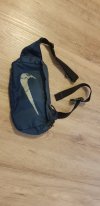This is a post I created a while back and will repost in hopes it helps.
There is a specific methodology that is used to properly size and fit a backpack. I cover that topic
HERE (click on the blue text)
When an experienced backpacker on this Forum says that a brand and model of a backpack like the Osprey Stratos or a Gossamer Gear Gorilla, or a zPacks Arc fits them well, that is a recommendation worth listening to. Should you then simply commit to purchasing that recommendation? Definitely no. Individual tastes and body types and anatomical irregularities means that, like an organ transplant, what one person finds comfortable and compatible may not work for someone else.
How should we make use of recommendations, then? The best thing to do is to consider knowledgeable recommendations for inclusion on a short list of candidates for testing as a personal match.
[This above also applies to footwear].
Do you need to go to a store in order to purchase a backpack that fits? No.
I am a firm believer that most people can do the steps that it takes to properly fit a backpack while at home, which opens up a whole world of backpack choices. You are not limited to the narrow selections at a single store.
When choosing a store for a backpack purchase (or footwear) you will have better luck at a specialty outdoor shop like REI,
IF it is well managed to include providing proficient staff training with quality assurance assessments of a salespersons skill. It is also important that the salespersons in the store do not appear to be harried if the store is busy, so only shop at hours when the shopping wave is at low tide.
Over the years I have helped many folks remediate issues with their backpacks and footwear that have been purchased thru an REI, and other specialty stores. Because of this, I would recommend
not -
as the first course of action - outright rejecting a backpack because it doesn't seem to 'feel' right' as you are testing it out in the store.
Why?
First: For a person in normal health ( you do not have unique physical issues that create challenges to achieving comfort}, it can often take time for your body to get used to the 'feel' of wearing a backpack, period. Everything from your center of gravity to your core muscles are doing something new, and It is likely that even a properly fitted and adjusted fully loaded backpack
will feel odd and out of place. This is especially true if you are new to wearing a regular backpack designed specifically for hiking, but also applies if it has been a while since backpacking or hiking.
Therefore when assessing the backpack in the store, do not be immediately put off because it feels strange; that may mean your body just needs a period of time to adapt to the feel of carrying a backpack as a new activity.
What you need to focus on is if the backpack is just outright uncomfortable to wear. The sales person should load the backpack with around 25 pounds/11.3 Kg. of weight. Walk around the store for at least 20 minutes. If there is discomfort caused by pressure points or digging into your body from a frame, shoulder harness, hipbelt, etc., that is a red flag.
On the other hand, if the backpack only feels like it is being just a tad nagging or niggling, it may indicate that your body needs time to get used to carrying any backpack. That process will take more time than from just wearing it around the store.
Make sure the return policy of the store allows you to return the backpack at least two weeks after purchase before you take a backpack home. REI and other outdoor shops have a terrific policy for returning gear and shoes even IF you wear it outdoors on backpacking trips.
If you make a purchase thru an online store like Amazon, most times the return policies are excellent
if the return is initiated within 30 days. You need to check the return policy information for specifics to be certain. If the online merchant is REI, for example, no problem. For an Amazon purchase, it can depend on the item, and if the shipping originates from Amazon itself or a third-party vendor
You will want to wear the backpack as often and for a long as you can during your at-home activities. If returns are allowed even if worn outdoors, then you can test it on long outdoor walks..
During this phase of testing for compatibility, load the backpack with between 15 to 25 pounds/ 7 to 9 kg. During the next 3 to 7 days, if the backpack begins to fade into the background so that it is no longer demanding attention, that indicates that it is a good match, not just for the 'fit', but for the 'feel', too.
You want a backpack that feels like you are wearing it, not carrying it as an external burden that is just hanging off of your body. You do not want the backpack to be demanding attention to itself, it must allow your mind to focus on the things around you that YOU want to focus on.
Keep in mind that no backpack will make the weight of a heavy load 'disappear' as if it does not exist. What a backpack should successfully do is to eliminate the nagging irritant of constantly asking, 'are we there yet?'
Second: It can be difficult to accurately assess a back if a salesperson is not doing a good job with the fittings and adjustments as you are trying out backpacks.
Over the years I have been invited by various stores, including some REIs, to in-service trainings for their staff on backpack and footwear fittings. As part of the training, I always inform the management that I will be sending in a 'shopper' 5 to 10 days after their staff was trained. Once the 'shopper' leaves the store with the backpack (or shoes/boots), I will check all the parameters of the fit and adjustments. Most times, the backpack and shoes are a spot-on match to the shopper, but not always; and when the fitting hadn't been correct, oft times it was significantly incorrect. I provide the feedback to the store management for his assessment of how s/he wishes to follow up with their staff.
At an outdoor equipment store, including any REI, if the backpack you are trying feels 'off', the first thing to do is to ask if another sales staff can be invited over to double check the fit and adjustments with your original salesperson. Ask to have them both take another look at your initial measurements to make sure they were correctly measured. Have them re-do the procedures to fit and adjust the backpack.
It could be that the salesperson misread the tape measure OR did not correctly identify where to place the tape measure in relationship to the top and bottom of the spine.
Note: never allow a salesperson to
only use a manufacturers' provided template to act as a fitting device; these will not always give a good measurement due to an individual's unique, anatomical variations - like scoliosis, or a deviation to the shoulder or pelvic girdles. Such anomalies can interfere with the proper positioning of the template. This is more likely to become an issue as one is past middle age.
Always insist on being measured with a measuring tape, and the preferable style of tape to use is a highly flexible fabric or paper tape similar to what a clothing fabricator or tailor would use. Also, tapes that are cheap may also be less than accurate, so keep that in mind, too.
Asking for additional assessment is NOT an insult to a sales person. Just tell the salesperson you are very interested in buying the backpack, but you want to completely rule out that the issues you are feeling about the backpack have nothing to do with how it fits. You simply want a second set of eyes to double check things and brainstorm a solution. Even an experienced sales person can be too complacent, distracted, or in a rush which may result in incorrectly 'seeing' the numbers, or incorrectly finding the proper locations on your body for positioning a hipbelt.
Your goal is to find a backpack that will become a great walking companion; it is also what the salesperson should be striving for. Do not worry about making the salesperson happy, worry about making your body happy. A happy body will help to make the camino pilgrimage a fond memory.
Additional Things To Ponder
Regardless of the backpack weight, your walking pace, or your daily fitness routines, etc., the key is to use common sense and reasonable expectations, follow any medical advice from you care provider, and avoid over exertions that can cause injury. Please consider the following:
- If you are new to distance walking and carrying a backpack, and you are wondering 'can I do this', it may be worthwhile to talk to your care provider for an honest assessment of your physical condition and listen to any concerns and suggestions that the provider may have. Please, consult with your physician.
- When testing the backpack at home, the load in the backpack should honestly reflect the amount of weight you are expecting to carry on a camino.
- If you discover that the weight of the backpack load is too heavy, then this is a good opportunity to evaluate how much stuff you plan to bring on a camino and whether a lighter version of those items can be substituted at a cost that doesn't break the bank.
- This Forum can help you to research how to lighten a backpack load by using the Forum Search Engine (at the top of the page in the blue menu bar, on the right side of the page). You can also start a thread and post a list of your backpack contents on the Forum. Members love to help, so do not be shy.
- Baggage transport is available. If the backpack is too heavy despite your best efforts, consider having a transport service carry some of your backpack inventory in a separate bag. You do not get extra Pilgrim Points and Gold Stars from being injured, or being miserable with a heavy backpack.
- When assessing the new backpack as part of a regular outdoor walking routine, you do not have to walk faster than your normal pace or walking speed, or walk extra-long distances.. It is far more important to spend time just wearing the backpack, even if what you are doing are normal household chores.































